Vietnam Technological & Commercial Joint Stock Bank Bundle
Who Really Owns Vietnam Technological & Commercial Joint Stock Bank?
Understanding a company's ownership structure is crucial for any investor or strategist. Techcombank, a leading financial institution in Vietnam, provides a compelling case study. Its journey from a startup to a publicly traded giant offers valuable insights into how ownership shifts impact strategy and performance. Uncover the key players shaping Techcombank's future.
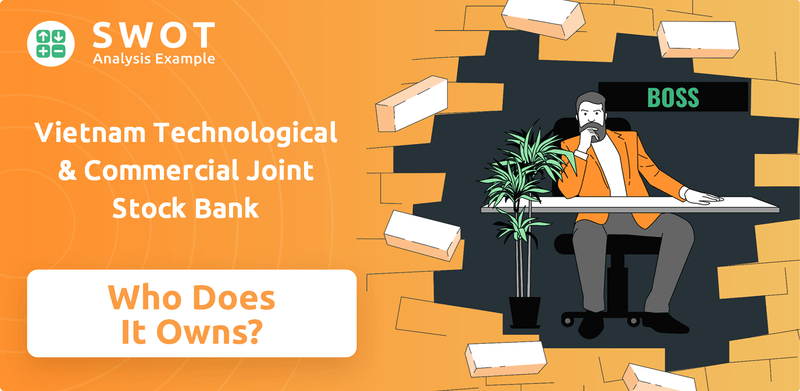
From its inception in 1993, Techcombank's ownership has evolved significantly, marked by its record-breaking IPO in 2018. This analysis explores the Vietnam Technological & Commercial Joint Stock Bank SWOT Analysis, delving into the bank's major shareholders and their influence. We'll examine the historical context, including the founders' vision and the impact of institutional investors, to understand the current Techcombank ownership landscape and its implications for investors and the broader Vietnamese economy. This investigation into Techcombank ownership is essential for anyone seeking to understand the bank's strategic direction and future prospects, including its financial performance and how to invest in Techcombank.
Who Founded Vietnam Technological & Commercial Joint Stock Bank?
The establishment of Vietnam Technological & Commercial Joint Stock Bank, also known as Techcombank, in 1993 marked the beginning of its journey in the Vietnamese financial sector. Initially, the bank was founded by Vietnamese entrepreneurs who had returned from Russia. This early phase set the stage for Techcombank's growth and development within the local market.
Early ownership of Techcombank involved a mix of private and state-affiliated investors. Domestic entities such as Vietnam Airlines and organizations linked to the Ministry of Science and Technology were among the initial backers. While the precise equity distribution among the founders and early investors isn't publicly available, these investments indicate a diverse ownership structure from the outset.
Over time, Techcombank's ownership structure evolved, incorporating both domestic and international investors. The bank's ability to attract foreign investment played a significant role in its development. These early ownership dynamics helped shape Techcombank's strategy and operational framework.
Techcombank was founded in 1993 by Vietnamese businessmen returning from Russia. This marked the beginning of its operations in Vietnam's financial sector.
Initial investors included domestic entities like Vietnam Airlines and organizations under the Ministry of Science and Technology. This mix of investors highlighted the early ownership structure.
In 2005, HSBC acquired a 10% stake in Techcombank. They increased their investment to 20% in 2008, bringing in international institutional ownership.
HSBC divested its entire stake in Techcombank in 2017. This marked a significant change in the bank's ownership composition.
The ownership structure has evolved, with both domestic and international investors playing roles. This evolution has influenced the bank's strategic decisions.
Early investors, including HSBC, have influenced Techcombank's strategic direction. The changes in ownership have shaped the bank's development.
The evolution of Techcombank's ownership structure, from its founding by Vietnamese entrepreneurs to the involvement of international investors like HSBC, showcases the bank's growth trajectory. The strategic investments and subsequent divestments have played a crucial role in shaping the bank's financial performance and market position. For more insights, you can explore the Growth Strategy of Vietnam Technological & Commercial Joint Stock Bank.
The initial ownership structure included founders and domestic investors. HSBC's investments in 2005 and 2008 brought in international capital. HSBC's complete exit in 2017 marked a significant change.
- Founders: Vietnamese entrepreneurs from Russia.
- Early Investors: Vietnam Airlines and entities under the Ministry of Science and Technology.
- HSBC Investment: 10% in 2005, increased to 20% in 2008.
- HSBC Divestment: Complete exit in 2017.
Vietnam Technological & Commercial Joint Stock Bank SWOT Analysis
- Complete SWOT Breakdown
- Fully Customizable
- Editable in Excel & Word
- Professional Formatting
- Investor-Ready Format
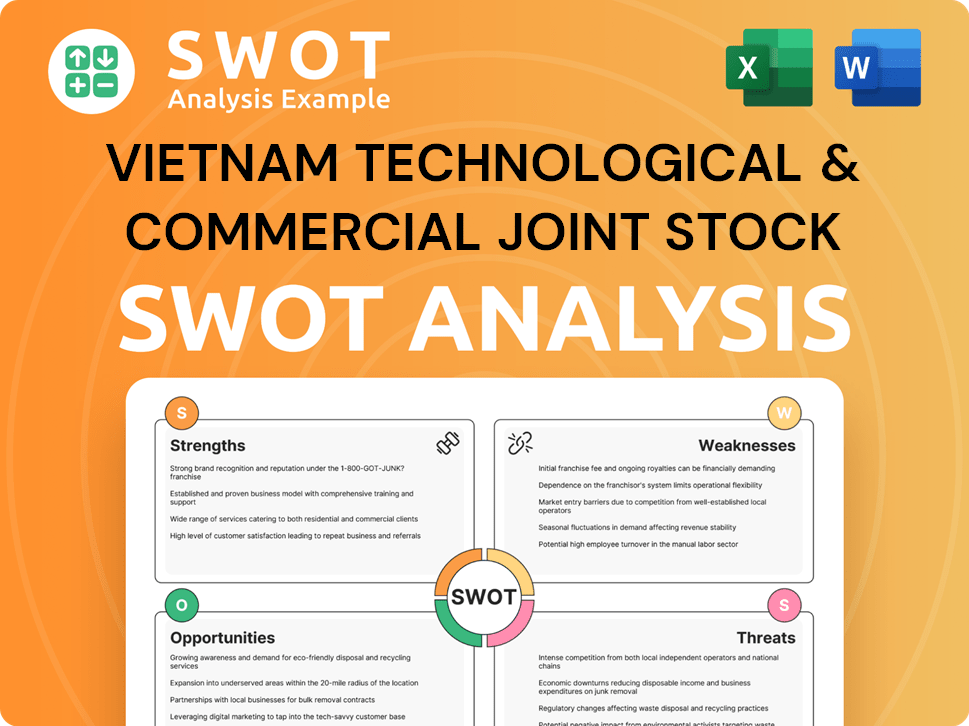
How Has Vietnam Technological & Commercial Joint Stock Bank’s Ownership Changed Over Time?
The ownership structure of Vietnam Technological & Commercial Joint Stock Bank (Techcombank) has seen several key changes since its inception. A significant event was its Initial Public Offering (IPO) in 2018, which was the largest in Vietnam's history at the time, raising over $900 million. This IPO saw shares allocated to cornerstone institutional investors, including GIC, Fidelity, and Dragon Capital. That same year, US private equity firm Warburg Pincus invested $370 million in the bank, further diversifying its ownership base.
As of December 31, 2023, Techcombank had 3,522,510,811 common shares issued. While specific percentages for major shareholders in 2024-2025 are not fully available, the presence of institutional and individual shareholders remains significant. As of December 31, 2022, major shareholders held 9% of the total common shares. Of this, institutional shareholders held 3.0% and individual shareholders held 3.4%. Foreign shareholders held 1.4% and domestic shareholders held 5.0% as of the same date. Masan Group Corp. and Dragon Capital Management (HK) Ltd. have been identified as major shareholders.
| Shareholder Type (as of Dec 31, 2022) | Percentage of Total Common Shares | Notes |
|---|---|---|
| Major Shareholders | 9% | Includes institutional and individual shareholders |
| Institutional Shareholders | 3.0% | |
| Individual Shareholders | 3.4% | |
| Foreign Shareholders | 1.4% | |
| Domestic Shareholders | 5.0% |
Recent reports, as of January 2025, indicate that foreign shareholders collectively owned approximately 22.5% of Techcombank's shares, nearing the 30% foreign ownership limit for Vietnamese banks. This suggests a diverse investor base with a strong presence of foreign capital. The bank's leadership has indicated plans to consider selling a 15% stake to a suitable foreign strategic investor in the near future, which would require existing foreign shareholders to sell to comply with the 30% cap. For more details, see Revenue Streams & Business Model of Vietnam Technological & Commercial Joint Stock Bank.
Techcombank's ownership has evolved significantly since its IPO in 2018, with substantial foreign investment.
- The IPO was a landmark event, raising over $900 million.
- Foreign ownership is approaching the regulatory limit of 30%.
- Major shareholders include institutional investors and Masan Group Corp.
- The bank may sell a 15% stake to a foreign investor, subject to regulatory compliance.
Vietnam Technological & Commercial Joint Stock Bank PESTLE Analysis
- Covers All 6 PESTLE Categories
- No Research Needed – Save Hours of Work
- Built by Experts, Trusted by Consultants
- Instant Download, Ready to Use
- 100% Editable, Fully Customizable
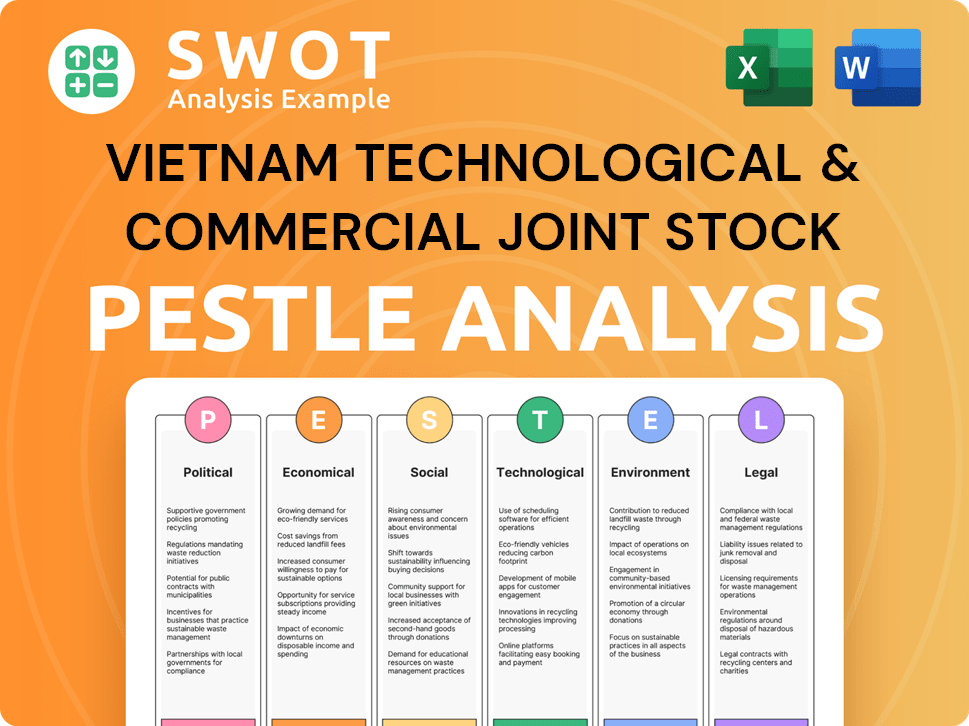
Who Sits on Vietnam Technological & Commercial Joint Stock Bank’s Board?
The Board of Directors (BOD) significantly influences the governance of Vietnam Technological & Commercial Joint Stock Bank, commonly known as Techcombank. The BOD includes representatives from major shareholders and independent members. As of July 5, 2024, the leadership includes Ho Hung Anh as Chairman and Jens Lottner as CEO. Understanding the structure of the board is essential for comprehending Techcombank's strategic direction and operational oversight.
Techcombank's voting structure follows a 'one share – one voting right' system. Shareholders with ordinary shares can combine their voting rights to nominate candidates for the Board of Directors. Shareholders holding between 5% and less than 10% of the total voting shares can nominate one candidate, while those holding 10% to less than 30% can nominate more candidates. This structure ensures that various shareholder interests are represented in the bank's governance.
| Board Member | Position | Date of Appointment (as of July 5, 2024) |
|---|---|---|
| Ho Hung Anh | Chairman | N/A |
| Jens Lottner | CEO | N/A |
| Various Other Members | Board Members | N/A |
The bank's charter, amended as of June 12, 2025, gives Techcombank the right to appoint the majority or all members of the Board of Directors if it or its related parties own more than 50% of the charter capital or voting shares. The Board reports on its activities and individual performance, and the Supervisory Board also reports on its performance and operation plan for the upcoming year. In 2025, the General Meeting of Shareholders approved all proposals from the Board, including the 2025 business plan and dividend distribution. This demonstrates the board's influence over the bank's strategic decisions and financial outcomes. For more detailed information, you can refer to the Techcombank's annual reports and investor relations materials.
The Board of Directors at Techcombank is led by Ho Hung Anh and CEO Jens Lottner. The voting structure is based on 'one share – one voting right'. Shareholders with significant holdings can nominate board candidates. The Board's decisions are crucial for the bank's strategic direction and financial performance.
- The Board of Directors plays a key role in Techcombank's governance.
- Shareholders can nominate candidates based on their voting rights.
- The bank's charter grants control to Techcombank if it holds over 50% of shares.
- The General Meeting of Shareholders approves the Board's submissions.
Vietnam Technological & Commercial Joint Stock Bank Business Model Canvas
- Complete 9-Block Business Model Canvas
- Effortlessly Communicate Your Business Strategy
- Investor-Ready BMC Format
- 100% Editable and Customizable
- Clear and Structured Layout
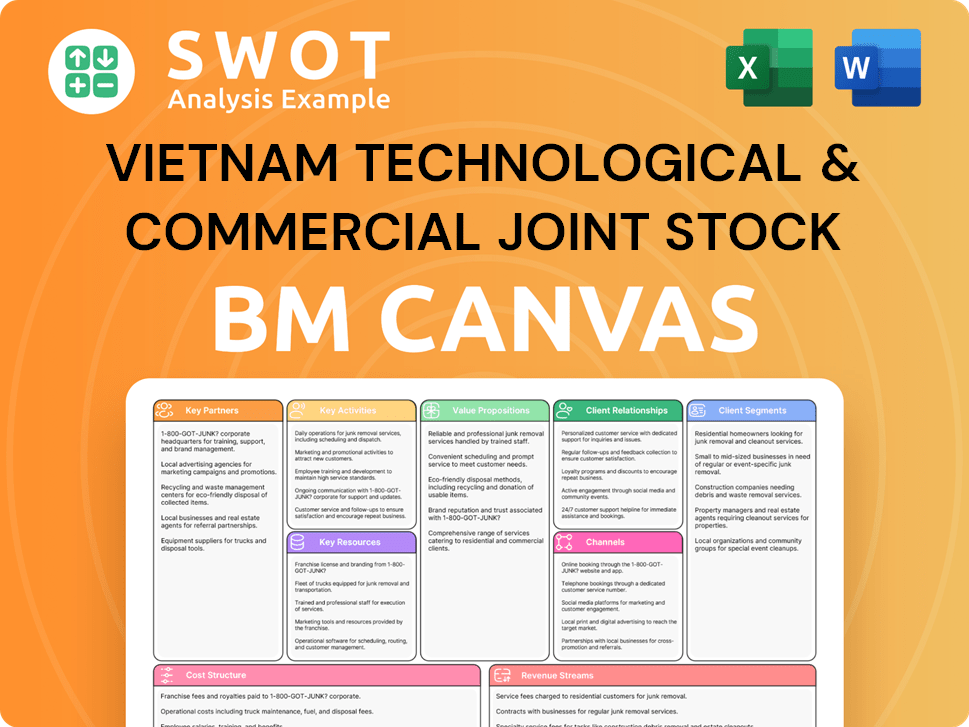
What Recent Changes Have Shaped Vietnam Technological & Commercial Joint Stock Bank’s Ownership Landscape?
Over the past 3-5 years, Vietnam Technological & Commercial Joint Stock Bank, known as Techcombank, has shown interesting shifts in its ownership and strategic direction. As of 2024, foreign ownership was around 22%, with the potential to increase to a 30% limit. However, the bank is not actively seeking foreign capital due to its strong financial standing.
In March 2025, Techcombank's board approved the establishment of TCLife, a life insurer. Techcombank will hold an 80% stake, equivalent to $41.6 million, with Vingroup as a major shareholder. By the end of 2024, Techcombank launched TCGIns, a non-life insurance brand, owning 11% of its charter capital of $20 million. These moves indicate Techcombank's strategy to build a comprehensive financial conglomerate.
| Aspect | Details | Year |
|---|---|---|
| Foreign Ownership | Approximately 22% | 2024 |
| TCLife Stake | Techcombank holds 80% | March 2025 |
| TCGIns Launch | Non-life insurance brand | End of 2024 |
Shareholder returns include a cash dividend of VND 1,500/share in 2024, followed by a planned cash dividend of VND 1,000/share in 2025. Techcombank also plans to issue over 21 million shares under an Employee Stock Ownership Plan (ESOP) in Q3 or Q4 2025. Chairman Ho Hung Anh announced in April 2025 the goal to expand market capitalization to $20 billion by the end of 2025. There are also plans for a potential IPO of Techcom Securities (TCBS) by the end of 2025.
Techcombank's ownership structure is evolving, with a focus on expanding into insurance and potentially listing subsidiaries. The bank is keen on attracting foreign investors, though not aggressively, due to its strong financial health. Shareholder returns remain a priority, with dividends and ESOPs planned for 2025.
The bank's moves into insurance and the potential IPO of TCBS demonstrate a strategy of diversification and growth. The market capitalization target of $20 billion by the end of 2025 highlights ambitious expansion plans. These strategic initiatives aim to strengthen Techcombank's market position.
Vietnam Technological & Commercial Joint Stock Bank Porter's Five Forces Analysis
- Covers All 5 Competitive Forces in Detail
- Structured for Consultants, Students, and Founders
- 100% Editable in Microsoft Word & Excel
- Instant Digital Download – Use Immediately
- Compatible with Mac & PC – Fully Unlocked
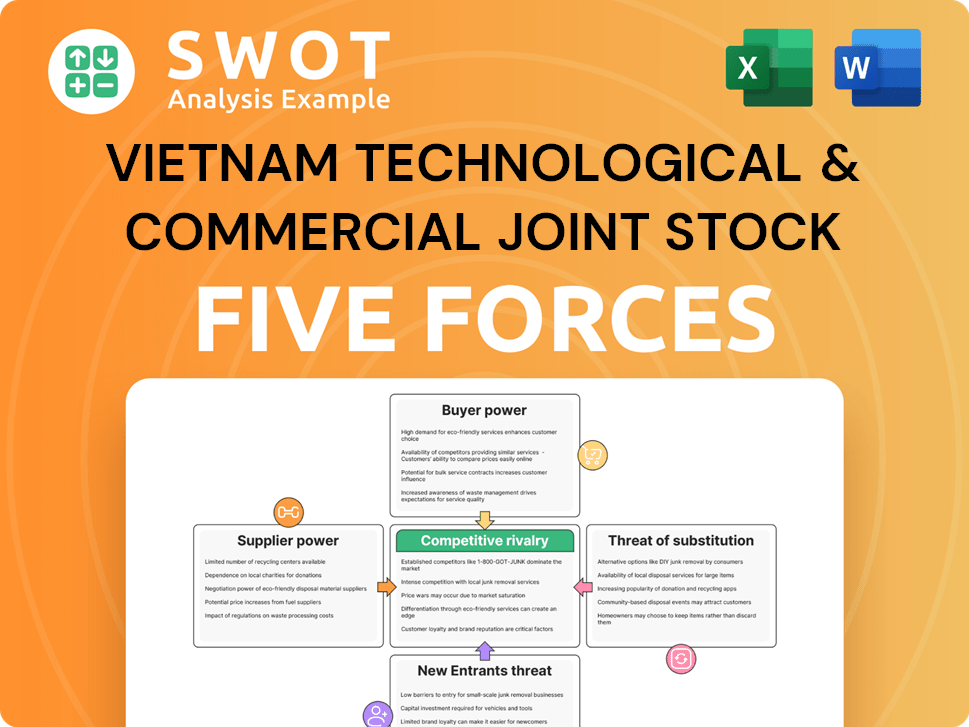
Related Blogs
- What are Mission Vision & Core Values of Vietnam Technological & Commercial Joint Stock Bank Company?
- What is Competitive Landscape of Vietnam Technological & Commercial Joint Stock Bank Company?
- What is Growth Strategy and Future Prospects of Vietnam Technological & Commercial Joint Stock Bank Company?
- How Does Vietnam Technological & Commercial Joint Stock Bank Company Work?
- What is Sales and Marketing Strategy of Vietnam Technological & Commercial Joint Stock Bank Company?
- What is Brief History of Vietnam Technological & Commercial Joint Stock Bank Company?
- What is Customer Demographics and Target Market of Vietnam Technological & Commercial Joint Stock Bank Company?
Disclaimer
All information, articles, and product details provided on this website are for general informational and educational purposes only. We do not claim any ownership over, nor do we intend to infringe upon, any trademarks, copyrights, logos, brand names, or other intellectual property mentioned or depicted on this site. Such intellectual property remains the property of its respective owners, and any references here are made solely for identification or informational purposes, without implying any affiliation, endorsement, or partnership.
We make no representations or warranties, express or implied, regarding the accuracy, completeness, or suitability of any content or products presented. Nothing on this website should be construed as legal, tax, investment, financial, medical, or other professional advice. In addition, no part of this site—including articles or product references—constitutes a solicitation, recommendation, endorsement, advertisement, or offer to buy or sell any securities, franchises, or other financial instruments, particularly in jurisdictions where such activity would be unlawful.
All content is of a general nature and may not address the specific circumstances of any individual or entity. It is not a substitute for professional advice or services. Any actions you take based on the information provided here are strictly at your own risk. You accept full responsibility for any decisions or outcomes arising from your use of this website and agree to release us from any liability in connection with your use of, or reliance upon, the content or products found herein.